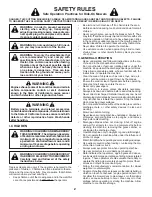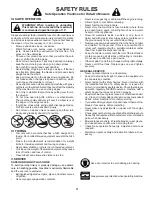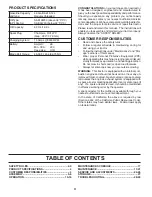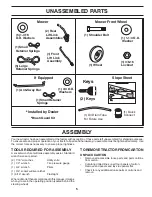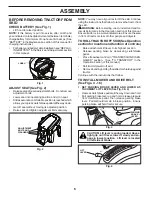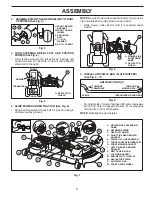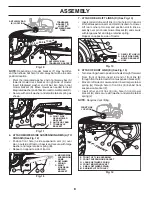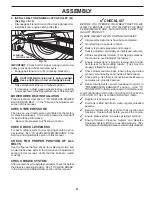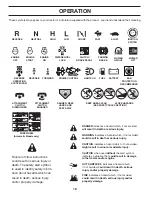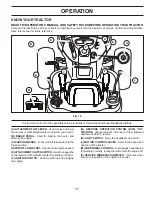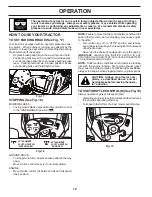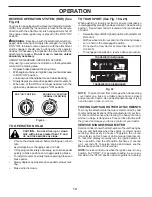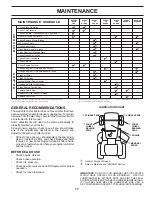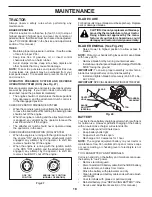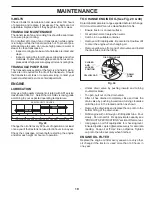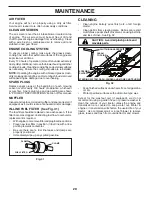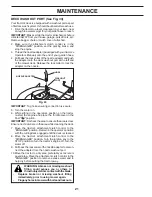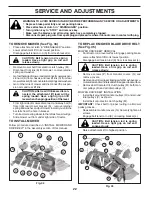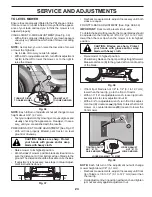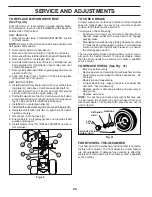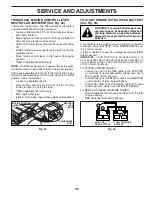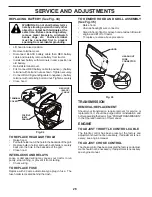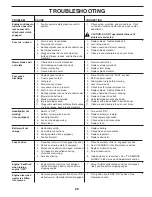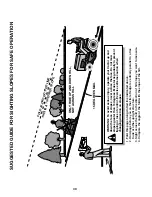
15
OPERATION
ADD GASOLINE
• Fill fuel tank to bottom of filler neck. Do not overfill.
Use fresh, clean, regular gasoline with a minimum of
87 octane. Do not mix oil with gasoline. Purchase fuel
in quantities that can be used within 30 days to ensure
fuel freshness.
CAUTION: Wipe off any spilled oil or
fuel. Do not store, spill or use gasoline
near an open flame.
IMPORTANT:
WHEN OPERATING IN TEMPERATURES
BELOW 32°F (0°C), USE FRESH, CLEAN WINTER GRADE
GASOLINE TO HELP ENSURE GOOD COLD WEATHER
STARTING.
CAUTION: Alcohol blended fuels (called gasohol
or using ethanol or methanol) can attract moisture
which leads to sep a ra tion and for ma tion of acids
during storage. Acidic gas can damage the fuel
system of an engine while in storage. To avoid
engine problems, the fuel system should be emptied
before stor age of 30 days or longer. Drain the gas
tank, start the engine and let it run until the fuel
lines and carburetor are empty. Use fresh fuel next
season. See Storage In struc tions for additional
information. Never use engine or carburetor cleaner
products in the fuel tank or permanent damage may
occur. Fuel stabilizer is an acceptable alternative
in minimizing the formation of fuel gum deposits
during stor age. Add stabilizer to gasoline in fuel
tank or storage container. Always follow the mix
ratio found on stabilizer container. Run engine at
least 10 minutes after adding stabilizer to allow the
stabilizer to reach the carburetor. Do not empty
the gas tank and carburetor if using fuel stabilizer.
BEFORE STARTING THE ENGINE
CHECK ENGINE OIL LEVEL
The engine in your tractor has been shipped from the fac-
tory already filled with sum mer weight oil.
• Check engine oil with tractor on level ground.
• Pull up and remove oil fill cap/dipstick; wipe oil off.
Reinsert the dipstick into the tube and push down firmly
into place. Remove and read oil level. If necessary,
add oil until “FULL” mark on dipstick is reached. Do
not overfill.
• For cold weather operation you should change oil for
easier starting. (See “OIL VISCOSITY CHART” in the
Maintenance sec tion of this manual.)
• To change engine oil, see the Maintenance section in
this manual.
TO START ENGINE (See Fig. 16)
When starting the engine for the first time or if the engine
has run out of fuel, it will take extra cranking time to move
fuel from the tank to the engine.
•
Ensure freewheel control is in the transmission en gaged
position.
•
Sit on seat in operating position, depress clutch/brake
pedal and set parking brake.
• Place motion control lever in neutral position.
• Move attachment clutch to “DISENGAGED” position.
• Move throttle control to choke position (if equipped).
NOTE:
Before starting, read the warm and cold starting
procedures below.
•
Insert key into ignition and turn key clockwise to “START”
position and release key as soon as engine starts.
Do not run starter continuously for more than fifteen
sec onds per minute. If the engine does not start after
several attempts, move throttle control to fast position,
wait a few minutes and try again. If engine still does
not start, move the throttle control back to the choke
position and retry.
WARM WEATHER STARTING (50°F/10°C and above)
• When engine starts, move the throttle control to the
fast position.
•
The attachments and ground drive can now be used. If
the engine does not accept the load, restart the engine
and allow it to warm up for one minute using the choke
as described above.
COLD WEATHER STARTING (50°F/10°C and below)
•
When engine starts, allow engine to run with the throttle
control in the choke position until the engine runs roughly,
then move throttle control to fast position. This may
require an engine warm-up period from several seconds
to several minutes, depending on the tem per a ture.
AUTOMATIC TRANSMISSION WARM UP
•
Before driving the unit in cold weather, the trans mis sion
should be warmed up as follows:
• Be sure the tractor is on level ground.
• Place the motion control lever in neutral. Re lease
the parking brake and let the clutch/brake slowly
return to operating position.
• Allow one minute for transmission to warm up. This
can be done during the engine warm up period.
• The attachments can also be used during the engine
warm-up period after the transmission has been warmed
up.


